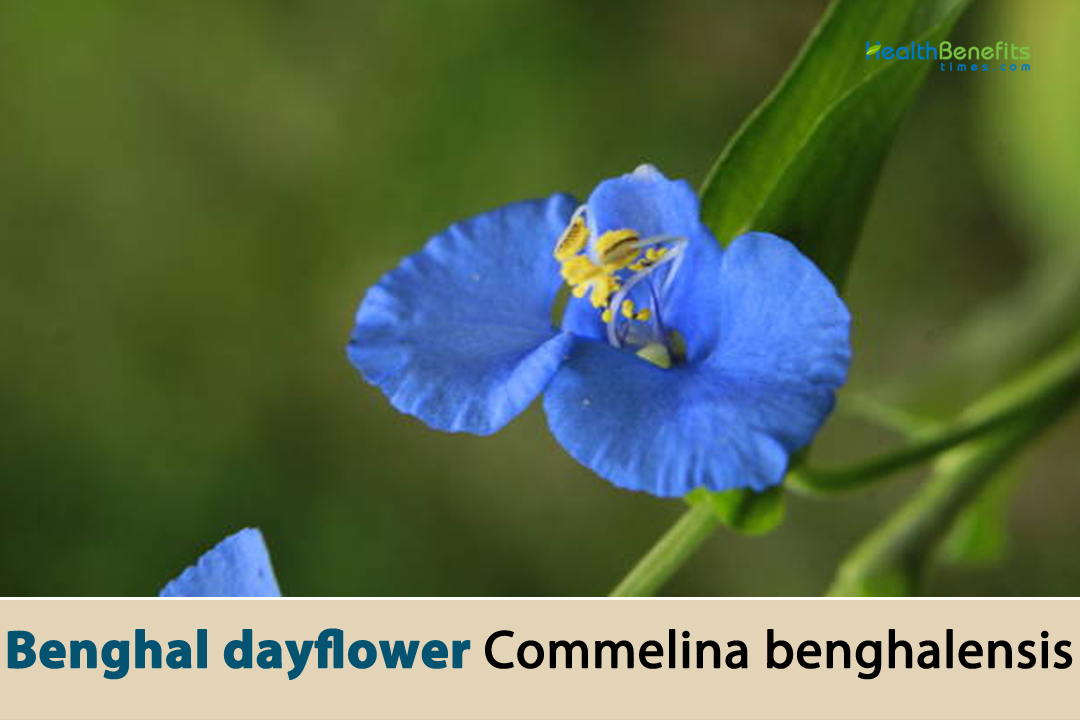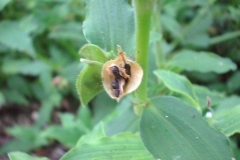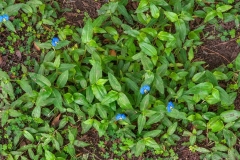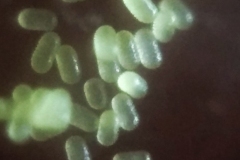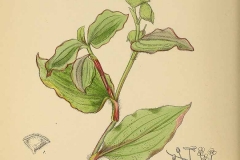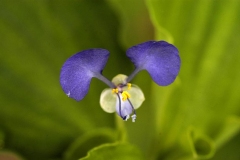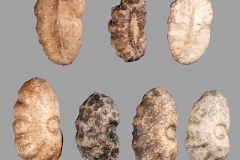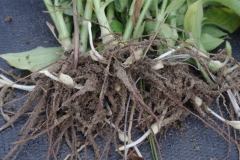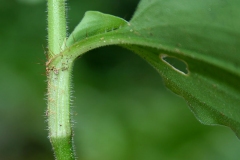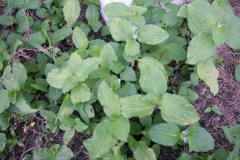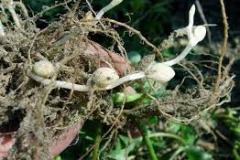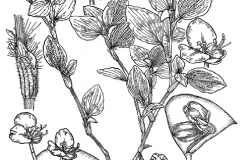The Dutch gardener Jan Commelijn (1629–1692) and his nephew Caspar (1667/1668–1731) are honored by the name of the genus Commelina. About 170 species live in the colder parts of the world, and 16 of those species live in southern Africa. This species is named for the part of India and Bangladesh where it lives, which is called Benghal. Benghal dayflower is famous not only because it looks beautiful, but also because it has many cultural, culinary, and medical uses as well. The leaves are picked from the wild for local use. In many places, they are seen as a food for times of famine and are only eaten then. The plant is also used to make a local medicine and a dye. In Malaysia, the live plants are sold at Chinese herb shops.
Also, it’s important to note that the Benghal dayflower has been used for many things in the past and is eaten as a vegetable in some countries. But it’s important to know how to identify Commelina and which types are safe to eat, because some species may have compounds that are toxic or allergenic. Even though the Benghal dayflower is pretty to look at, it is important to know that in many parts of the world, it is called an invasive species. It spreads quickly because it can adapt to different conditions, grows quickly, and makes a lot of seeds. As an invasive species, it can beat out local plants, mess up ecosystems, and make it hard to grow crops.
Benghal Dayflower Facts
| Benghal dayflower Quick Facts | |
|---|---|
| Name: | Benghal dayflower |
| Scientific Name: | Commelina benghalensis |
| Origin | Africa, the Arabian Peninsula, the Indian Sub-continent, southern China, Japan and south-eastern Asia |
| Colors | Green when immature, turning brown as they mature |
| Shapes | Small, round capsules measuring approximately 1 centimeter in diameter and contain black seeds |
| Health benefits | Treat insomnia, cataracts, night blindness, otitis media, suppurative sores, snakebites, inflammation, burns, conjunctivitis, headaches, toothaches, eczema, abscesses, acne, scabies, warts, respiratory and mental problems. |
| Name | Benghal dayflower |
|---|---|
| Scientific Name | Commelina benghalensis |
| Native | Africa, the Arabian Peninsula, the Indian Sub-continent, southern China, Japan and south-eastern Asia |
| Common Names | Benghal dayflower, Indian dayflower, Jio, Dayflower, Hairy wandering-Jew, Wandering-Jew, Day Flower, Benghal wandering Jew, tropical spiderwort, whiskered Commelina, tropical spiderwort, Fire Leaf, Garden Commelina, Blue spiderwort, Dew flower, Asiatic dayflower, Creeping dayflower, Benghal Commelina |
| Name in Other Languages | Afrikaans: Gewone blousebloommetjie, Bengaalse wandelende Jood Amharic: Wefa’anik’uri (ወፋኣንቁር) Arabic: Bayad (بياض), hulib (هوليب), waealan, halib (وعلان، هليب) Assamese: Bangali Phool (বঙ্গালী ফুল), Kona-shimolu, Kona Simolu, konaximolu (কনাশিমলু) Bengali: Bongol Shap (বঙ্গল সাপ), Dholpata (ঢোলপাতা), Kanshira, Kanaibashi Cebuano: Sabilau Chinese: Fan bao cao (飯包草), Yuán yè yā zhí cǎo (圓葉鴨跖草), Huǒchái tóu (火柴头), Zhú yè cài (竹叶菜), Mǎ ěr cǎo (马耳草), Luan ye yi zhi cao (卵叶鸭趾草) Comorian: Coha, Itswamli, Nrambantsi Danish: Bengaldagblomst Dutch: Bengaalse dagbloem English: Benghal dayflower, Indian dayflower, Jio, Dayflower, Hairy wandering-Jew, Wandering-Jew, Day Flower, Benghal wandering Jew, tropical spiderwort, whiskered Commelina, tropical spiderwort, Fire Leaf, Garden Commelina Finnish: Bengalintädyke, Intiansoljo French: Commeline du Bengale, herbe aux cochons Fulah: Uppurwa German: Bengaltagblume, Commeline, Bengalische, bengalische Commeline Gujarati: Bangal Kaneri (બંગાળ કણેરી), Bangal Phool (બંગાળ ફૂલ), Motun shishmuliyun (મોટું શીશમૂળિયું) Hawaiian: Hairy honohono Hindi: Bangal Sambha (बंगल संभा), Kanchara, kanasiri, kanchara, kankaua, kena, konasimalu, krishnaghas, mankawa, buchna, kana, kinkawwa, Kanteri, Kanuraka, Kaua-kaini, Jalbhu, Kanakaua, Kankawa, Kana (काना), jal-bhu (जल भू), kanakaua (कनकउआ), kena (केना), krishna ghas (कृष्ण घास), Buchna (बुचना) Indonesian: Gewor, Pentugan, Kekupu, Tali korang Ibatan: Kuhasi Iloko: Kulkulasi Irula: Kayinai Italian: Commelina del Bengala Japanese: Tsuyukusa, marubatsuyukusa (マルバツユクサ) Kannada: Bengal Kuvale (ಬೆಂಗಾಲ್ ಕೂವಲೆ), Bengal Divya (ಬೆಂಗಾಲ್ ದಿವ್ಯ), Hittagani, Gubbachchi bale (ಗುಬ್ಬಚ್ಚಿ ಬಾಳೆ), Gubbachchi basale (ಗುಬ್ಬಚ್ಚಿ ಬಸಳೆ), gubbachchi bale (ಗುಬ್ಬಚ್ಚಿ ಬಾಳೆ), kanne soppu (ಕನ್ನೆ ಸೊಪ್ಪು) Kapampangan: Biasbias Konkani: Kamchat (कंचट) Korean: Gokkaldalg-uijangpul (고깔닭의장풀) Laos: Kaab pii Malagasy: Moravelona, Sofinakanga Malayalam: Bangali Poov (ബംഗാളി പൂവ്), kaanavaazha (കാനവാഴ), Kanankolai, Kancatam, Kanavazhai, വാഴപ്പടത്തി (Vuzhaipadathi), Adukkavettila, kanavazhai Malaysia: Rum put mayiam Manipuri: Kena (केना), wangden khoibi (ৱাঙদেন খোইবী) Marathi: Bangal Sadaharitr (बंगाल सदाहरित्र), , kena (केना), Kanchat Myanmar: Myet-cho Nepali: Bangali Phool (बंगाली फूल), kaane ghaans (काने घाँस), Kane Norwegian: Bengalisk dagblomst Odia: କଞ୍ଚଡ଼ କାଙ୍କୁ kanchara kanku Oriya: ବଂଗାଳି ଫୁଲ (Bangali Phula), କନିଶିରି Pampangan: Bias-bias Philippines: Alikbangon, bias-bias, kuhasi, kulkulasi, sabilau Portuguese: Commelina de Bengala, Marianinha, Mata-brasil, Trapoeraba, andaca, andarca, erva-de-santa-luzia, folhas-de-pé-de-áden, maria-mole, marianinha-branca, rabo-de-cachorro Punjabi: Bangali Phull (ਬੰਗਾਲੀ ਫੁੱਲ) Russian: Kommielina bienhaĺskaja (коммелина бенгальская) Samoan: Mau‘u Toga, mau‘u toga Sanskrit: Kanchata (कञ्चट), Marishajalaja, Paniya, Vatspriya, Karnamorata, Karnasphota, Kosapuspi Sinhala: Bengali Mala (බෙංගලි මල්), Diya meneriya (දිය මෙනේරිය ) Sotho: Khotswana Spanish: Commelina de Bengala, golondrina, matalí Sundanese: Tali korang, gèwor Swedish: Bengalisk dagblomma, Indisk himmelsblomma Tagalog: Alikbangon Taiwan: Ju-ye-tsai Tamil: Vengalai Muthu (வெங்களை முத்து), Kaṉavāḻai (கனவாழை), Adutinna-thalai, Kan-an-kolai, Kanavalai, Kanavazhai, Kanavazhar, kan-an-kolai (கானாங்கோழை), kanavalai (கனவாழை) Telugu: Bangala Akku (బంగాళ అక్కు), Amruta kaada, Neerukaassuvu, amruta kaada (అమృత కాడ), neerukaassuvu (నీరు కసువు), venna devikura (వెన్నదేవి కూర), venna veduru (వెన్నవెదురు), yanadra aaku (యాండ్రఆకు) Thai: Dxk mị̂ bạng kạs̄ (ดอกไม้บังกาล), P̄hạk plāb (ผักปลาบ) Tongan: Kaningi, kanini, musie matala pulu Tulu: Kannechappu (ಕನ್ನೆಚಪ್ಪು) Urdu: Bangal Sadaharitr (بنگال سداہرتر), Bangali Phool (بنگالی پھول) Xhosa: Uhlotshane Zimbabwe: Chidyahumba, gezi, goche, idabane Zulu: Idlebendlele, Idambizo |
| Plant Growth Habit | Annual or perennial, herbaceous, mucilaginous, slender, creeping or ascending, branched plant |
| Growing Climates | Open fields, home gardens, edges of forests, disturbed areas, roadsides, grasslands and other disturbed areas |
| Soil | Prefers well-draining soil that retains some moisture without being overly saturated. It can tolerate a wide range of soil pH levels, but it generally prefers slightly acidic to neutral conditions |
| Plant Size | Height of 20-60 centimeters |
| Root | Fibrous root system that consists of numerous small roots that branch out in various directions |
| Stem | Long, slender, and flexible, allowing the plant to climb on nearby vegetation or sprawl along the ground |
| Leaf | Elongated and typically ovate in shape. They have a broad, rounded base that tapers towards the tip, forming a pointed apex |
| Flowering season | May to October |
| Flower | Usually small, three-petaled, and come in shades of blue or purple. Each flower lasts only for a day, and new flowers bloom daily throughout the flowering season |
| Fruit Shape & Size | Small, round capsules measuring approximately 1 centimeter in diameter and contain black seeds |
| Fruit Color | Green when immature, turning brown as they mature |
| Seed | Relatively small and have a rounded shape, measuring approximately a few millimeters in diameter |
| Flavor/Aroma | Mildly pungent or earthy |
| Varieties |
|
| Plant Parts Used | Leaves, stems, roots and whole plants |
| Propagation | Through seeds, division and stem cuttings |
| Lifespan | Within a single year |
| Season | July to December |
| Health benefits |
|
Plant Description
Benghal dayflower is an herbaceous, mucilaginous, thin, creeping or climbing, branched, annual or permanent plant that usually grows between 20 and 60 cm tall. The plant grows in open fields, home gardens, the edges of woods, disturbed areas, roadsides, woodland, grasslands, tree plantations, other disturbed areas, bush land, running water lands, waste ground, moist grassland, agriculture field and marshlands. The plant does best in dirt that drains well and holds some water without being too wet. It can grow in a wide range of soil pH levels, but it usually does best in soil that is slightly acidic or neutral. Soils that are sandy, loamy, or clayey are often thought to be the best because they drain well and hold enough water and nutrients. Adding compost or well-rotted dung to the soil can make it more fertile and better able to keep water in it. This can help the Benghal dayflower stay healthy and grow.
Roots
The roots of the benghal dayflower are flexible, which means they are made up of many small roots that grow in different directions. Benghal dayflower is a monocot, which means it has a woody root system. This helps the plant absorb nutrients and stay stable. Most of the time, the roots are thin and soft. They have thin, branching structures that make it easier for them to take in water and nutrients from the earth. The plant has adapted to its natural environment and is able to explore a wide range of soil sizes because its roots are thin.
The size of the roots depends on many things, like how old the plant is, how the soil is, and what resources are present. When a plant is a seedling or just getting started, its roots are small and not as well formed. As the plant gets older and its root system gets stronger, the roots get longer and stronger, which helps the plant grow and spread. Its roots tend to spread out across the ground rather than down into the ground. The fibrous roots grow sideways in the earth, covering more ground and allowing the plant to get the most water and nutrients. But the depth to which the roots grow into the soil can change based on how the soil is made and how much water is in it. In soils that drain well, the roots may grow to a modest depth. In soils that are hard or full of water, however, the root system may be shallower.
Stem
Benghal dayflower can grow either by rising or by crawling, depending on where it can find support. The stems are long, thin, and bendy, which lets the plant climb on other plants or spread out on the ground. The way the Benghal dayflower climbs helps it get lighter and compete for room. Most of the time, the branches are green, which shows that the plant can do photosynthesis. They are succulent, which means that they have tissues that store water and help the plant survive in dry or arid circumstances. The plant looks full and thick because of how the succulent stems make it look.
Stems can be different lengths based on how they grow and what they have to lean on. When conditions are good and the roots have enough support, they can grow up to 2 meters tall. But when they grow in places where they don’t have enough support, the roots may be shorter and spread out along the ground. Stems often make thin structures that look like tendrils that help the plant climb and stick to nearby objects. These buildings protect the plant and let it get more sunlight. The tendril-like structures can grow at regular intervals along the stems, giving the plant more places to connect and stay stable.
Leaves
Most of the time, the leaves are long and ovate in shape. They have a wide, round base that narrows to a sharp point at the top. The tips of the leaves are smooth and wavy, giving them a wavy look. In general, the shape of the leaves is pleasing to the eye. The leaves have various veins that run parallel to each other from the base to the tip. This is called parallel venation. This leaf’s structure is held up by these parallel veins that branch out from the center midrib. The straight veins make it easier for the plant to move water, nutrients, and sugars all over the leaf.
The size can change based on how old the plant is and how the environment is. The leaves are about 10 centimeters long on average. But the size can vary from small leaves that are just starting to grow to bigger leaves that have grown more. When compared to fully grown leaves, younger leaves may be a little bit smaller. Most leaves are shiny green, which shows that they are healthy and strong. The plant looks beautiful and healthy because of its bright green color. The leaves feel smooth and a little bit thick. Herbaceous plants have this texture because they don’t have the thick, woody structure that trees and bushes do. The smooth surface of the leaves makes them look and feel better.
Flower
Flowers have a unique form with three petals that make them stand out. Two of the petals are big and showy, while the third petal is usually smaller and lighter in color. The big petals are round and have a small depression at the base, which gives them a heart-like shape. The smaller flower is also rounding, but its shape may be more oval. Together, these three petals make a flower shape that stands out. The flowers are fairly small, with a width of about 2 to 3 centimeters. The size may be a little different based on the type of plant, how it grows, and when each flower is ready. Even though they are small, their bright colors and unusual shapes make them stand out.
The flowers are known for their beautiful blue color, which often has a hint of purple. The plant’s bright blue color is one of its most noticeable features and adds to its general beauty. Each flower may have a slightly different amount of color, but the blue color is what makes it stand out. Each flower only lasts for a short amount of time. It only blooms for a short time before it fades and dies. But because the plant keeps making new buds, it can keep blooming for a long time and show flowers all the time.
Fruits
Small, round shells with seeds inside are made by the plant. These shells help the Benghal dayflower spread its seeds and make more plants. The pills, on the other hand, are not usually called fruits. The capsules are about 1 centimeter in diameter, so they are not very big. They are round and look green when they are young. As they get older, they turn brown. When the shells break open, the black seeds inside are spread around. It’s important to know that the Benghal dayflower’s shells and seeds help the plant reproduce, but they are not edible and are not used in cooking.
Seeds
The seeds are small and have a round shape. People usually say that they are round or slightly flattened. The form of the seeds can be a little different, but they are usually small and round. The seeds are small, with a width of about a few millimeters. The exact size of each seed may change, but in general, they are small and compact compared to the seeds of other plant species.
Most of the time, the seeds are black. Their dark color keeps them safe and helps them fit in with their surroundings. The black color helps absorb heat, which makes it easier for seeds to grow when conditions are right. The seeds are smooth and have a shiny surface. This makes it easy for the particles to move around and spread out in the environment. The smooth smoothness also helps keep the seed from drying out and protects it from damage from the outside. Seeds have something called a seed coat that protects them. The seed coat is not very thick, so it protects the seed from things like water and disease-causing organisms. It is a very important part of keeping the seed alive and healthy until the right conditions come along for it to grow.
History
Benghal dayflower is thought to have come from India, more specifically from the Bengal area. Benghal dayflower is a popular name for this plant because it grows in this area. But it’s important to know that the Benghal dayflower is a plant that can grow well in many warm and subtropical areas around the world. The plant has been brought to other parts of Asia, Africa, the Americas, and other warm and subtropical areas. People are thought to have spread it by doing things like trading, moving, and moving goods and farming products.
Benghal dayflower is still around and growing in many places, both as a domesticated plant and as a species that has escaped into the wild. It can live in many different places because it can change and adapt. This makes it hard to control or get rid of in some places. People are trying to spread the word about how invasive it is and find ways to control it in a way that doesn’t harm the environment too much.
Varieties of Benghal dayflower
There are several recognized varieties of Commelina benghalensis, commonly known as Benghal dayflower. These varieties may exhibit slight variations in characteristics such as flower color, leaf shape, or growth habit. Here are some notable varieties:
- Commelina benghalensis var. benghalensis: This type of Benghal dayflower is the most popular one. It has bright blue flowers and oval leaves that are long and narrow. This type is common and can grow in many different kinds of environments.
- Commelina benghalensis var. aquatica: This variety is well-suited to living in water. It usually grows in marshes, wetlands, and by rivers. It has bigger leaves than other types, and it can stand being wet for a while.
- Commelina benghalensis var. prostrata: This type grows in a way that looks like it’s lying down, with stems that spread out over the ground. It usually grows in places that have been disturbed, like farms, parks, and the sides of roads. Compared to other kinds, the prostrate type may have shorter stems and smaller flowers.
- Commelina benghalensis var. luxurians: This type is known for its strong growth and thick, green leaves. It usually has bigger leaves and stronger stems, which make it a bigger plant altogether. The luxurians version might have stronger branches and make more flowers.
- Commelina benghalensis var. albiflora: This means that some Benghal dayflower plants have white flowers instead of the usual blue ones. Some groups have plants with white flowers, which add to the variety of the species.
- Commelina benghalensis var. aureostriata: This variety has leaves with yellow or golden stripes or lines that stand out against the green foliage. The variation can happen on its own or because of changes.
- Commelina benghalensis var. viridis: This variation is found in plants with greener leaves than the usual blue-green ones of Benghal dayflower. The var. viridis leaves may look brighter or be a different shade of green.
Morphological characteristics of the plant
| Characteristics | Leaf | Stem | Root | Flower | Seed | Spath |
| Color | Green | Green and reddish at the node | Light brown or white | Blue-violet | Black to brown | Green |
| Odor | Odorless | Odorless | Odorless | Odorless | Odorless | Odorless |
| Taste | Mucilaginous | Mucilaginous | ——- | ——- | ——- | ——- |
| Size | 2.5-7.5 cm long and 1.5-4 cm wide | 10-30 cm in height & 20-90 cm in length | ———- | 10-20 mm long and 10-15 mm wide
Peduncles 1-3.5 mm long |
1.6-3 mm long and 1.3-1.8 mm wide | 1.5 cm |
| Shape | Ovate-lanceolate | Cylindrical | Cylindrical | Triangular
(butterfly), funnel, |
Rectangular | Funnel &
compressed |
| Extra Feature | Parallel venation, entire
margin, sheath red with white hairs |
——- | ——- | Produce in spath,
petals 3-4 mm long |
Netted appearance | ——- |
Health Benefits of Benghal Dayflower
Benghal dayflower (Commelina benghalensis) not only exhibits a captivating appearance but also possesses various health benefits. This remarkable plant has been utilized in traditional medicine for centuries due to its medicinal properties. Let’s explore the detailed health benefits of Benghal dayflower:
1. Anti-inflammatory properties
Benghal dayflower has chemicals in it that help reduce inflammation. Because of these qualities, it can help reduce inflammation caused by illnesses like arthritis, gout, and inflammatory bowel diseases.
2. Antioxidant activity
Benghal dayflower has a lot of antioxidants, which help fight oxidative stress and lessen the damage done by dangerous free radicals. Antioxidants are a key part of lowering the chance of chronic diseases like heart disease, cancer, and neurodegenerative disorders.
3. Digestive aid
Benghal dayflower has been used for a long time to help with stomach problems like indigestion, gas and diarrhea. There are chemicals in the plant that may help control digestion and improve the health of the digestive tract.
4. Diuretic effect
Benghal dayflower is a diuretic, which means that it causes more pee to be made. This can help people who have trouble keeping fluids out of their bodies and may help flush out toxins.
5. Anti-microbial activity
Studies have shown that the Benghal dayflower has antimicrobial qualities that make it useful against some types of bacteria and fungi. These qualities might help fight infections and boost the immune system as a whole.
6. Wound healing
Benghal dayflower has been used to heal wounds by people who practice traditional medicine. The plant has chemicals in it that may help damaged cells heal faster and grow back stronger.
7. Anti-allergic effects
Benghal dayflower might have anti-allergic effects, which could help people who have allergies. It might help relieve things like coughing, itching, and stuffy noses.
8. Liver support
Benghal dayflower has always been used to help keep the liver healthy. Compounds in the plant may help with cleansing, protect liver cells from damage, and help the liver work at its best.
9. Cardiovascular health
Early research suggests that Benghal dayflower may be good for your heart. It might help control blood pressure and cholesterol levels, making heart disease less likely.
10. Anticancer potential
Even though more research needs to be done, early studies have shown that Benghal dayflower products may help fight cancer. These results show that the plant could be a source of natural compounds for cancer studies in the future.
11. Anti-diabetic effects
Benghal dayflower has been looked into to see if it could help with diabetes. Some studies show that it may help control blood sugar and make the body more sensitive to insulin.
12. Antidepressant properties
Benghal dayflower has been used traditionally as a herbal treatment for anxiety and sadness. There may be chemicals in the plant that help keep your mood stable and make you feel good.
13. Anti-aging benefits
Benghal dayflower might be able to slow the ageing process because it has antioxidant qualities. Antioxidants protect against oxidative stress, which is a major cause of ageing and illnesses that come with it.
14. Anti-ulcer activity
Some studies have shown that Benghal dayflower products can help heal ulcers. Compounds in the plant may help protect the stomach walls, lower the amount of acid made by the stomach, and lower the risk of gastric ulcers.
15. Pain relief
Benghal dayflower has been used to relieve pain for a long time. It might make headaches, muscle aches, joint pain, and menstrual cramps less painful and uncomfortable.
Traditional uses and benefits of Benghal dayflower
- In Cameroon, people use the stem to look into wounds.
- It is used in Kenya to treat eye problems caused by measles.
- In India, it is used to treat leprosy and problems with the nervous system.
- It is also said to help with mouth thrush, inflammation of the conjunctiva, madness, epilepsy, insanity, and exophthalmia.
- In China, it is used as a laxative, a fever reducer, and a painkiller.
- Different parts of the plant are used in traditional medicine to treat things like fever, inflammation, and stomach problems.
- The dried leaves and stems are often used to make drinks or to treat pain and swelling on the skin.
- The dust in your eyes can be cleaned with the juice from the stem.
- In southern Nigeria, the plant is used to treat sore feet with a salve.
- In East Africa, the sap of the leaves and stems is used to treat eye problems, sore throats, and burns. In Zanzibar, the liquid in the flowering spathe is used to treat eye problems.
- The sap is put on the skin of babies with thrush in Uganda and Tanzania.
- To treat diarrhea in Tanzania, crushed leaves soaked in warm water are used to make a treatment.
- In southern Africa, it is used to help women who can’t have children get pregnant again. A decoction of the root is also used to treat stomach problems.
- In India, they say it can help people with leprosy.
- In the Philippines, it is used as a suppository for strangury that soothes the throat.
- In the Indian state of Rajasthan, sheep with jaundice are given a mixture of the plant, whey, and salt.
- In Pakistan, it is used as a food and also as a laxative and an anti-inflammatory drug to treat leprosy.
- In Nepal, burns are treated with plant paste, and stomach problems are fixed with root juice.
- In Bangladesh, this plant is used to treat insomnia, cataracts, conjunctivitis, night blindness, suppurative sores, otitis media, toothaches, snakebites, inflammation, burns, headaches, warts, eczema, abscesses, scabies, acne, respiratory and mental problems.
Culinary uses of Benghal dayflower
Benghal dayflower (Commelina benghalensis) has culinary uses in certain cultures where it is incorporated into traditional dishes. The plant’s leaves are primarily used for culinary purposes, offering a unique flavor and texture to various recipes. Here are some culinary uses of Benghal dayflower:
- Salads: The raw leaves of the benghal dayflower can be used in salads to give them a fresh and lively taste. The leaves have a mild flavor that goes well with things like mixed greens, veggies, or fruits in a salad. They can make salads look better by giving them color and a different structure.
- Stir-fries and Sautéed Dishes: Benghal dayflower leaves make a tasty side dish when they are sautéed or stir-fried. They can be cooked quickly with garlic, onions, or other spices to make a tasty side dish for a main dish. When the young leaves are cooked, they keep their bright color and slightly crunchy texture.
- Soups and Stews: The leaves of the benghal dayflower can be added to soups and stews to make them healthier. You can add them at the end of cooking so that they keep their bright color and delicate flavor. The leaves can be used in classic soup recipes to make them taste and look better.
- Fritters and Pakoras: The leaves of the benghal dayflower can be used to make fritters or pakoras, which are famous snacks in some parts of the world. The leaves are dipped in a batter, which is usually made with gram flour and spices, and deep-fried until crispy. This way of cooking brings out the taste and texture of the leaves, making for a savory and crunchy snack.
- Leafy Vegetable: Commelina benghalensis is a plant whose leaves are used as a green food in many dishes. You can cook them and eat them as a healthy green food. The leaves are often cooked, sautéed, or stir-fried, and they can be eaten as a side dish or added to main dishes.
- Curries and Stir-fries: Commelina benghalensis is a plant whose leaves are used as a green food in many dishes. You can cook them and eat them as a healthy green food. The leaves are often cooked, sautéed, or stir-fried, and they can be eaten as a side dish or added to main dishes.
- Soups and Stews: Leaves from Commelina benghalensis can be added to soups and stews to make them healthier. You can add them to vegetable soups or mix them with other greens to make rich stews. They give each dish a different flavor. The leaves give the end dish both flavor and visual appeal.
- Traditional Dishes: Commelina benghalensis leaves are used in some native dishes that are only found in that area. These meals can be made from local recipes, cultural specialties, or traditional ways of cooking where the leaves are used to give the food a unique flavour and cultural meaning.
Different uses
Commelina benghalensis is a species of ornamental plant that grows in tropical and subtropical areas. It is also known as the Benghal dayflower or tropical spiderwort. It can be used in a lot of different ways and fields. Here are some of the different uses of Commelina benghalensis:
- Soil erosion control: Commelina benghalensis is often used in projects to protect the soil. Its dense growth and large root system help support the soil, stop it from washing away, and stop weeds from growing. It is especially helpful in places that are prone to erosion, such as slopes, embankments, or fields that have been plowed or burned.
- Ornamental plant: Commelina benghalensis is grown as an ornamental plant in parks and landscapes because it has beautiful blue flowers and lush green leaves. It looks nice and can be grown on the ground or in pots.
- Animal forage: Commelina benghalensis is used as feed for animals and cattle in some places. It is thought to be healthy and can be used as an extra food source, especially during dry times when there isn’t much else to eat.
- Research and education: Commelina benghalensis is also used in botanical and scientific study. Researchers in plant physiology, ecology, and taxonomy are interested in it because of its unique traits and growth trends. It is also used in schools to teach children about the different kinds of plants and about biology.
Precautions
The Benghal dayflower has been associated with some potential side effects and considerations:
- Allergic reactions: Like many other plants, Benghal dayflower may cause allergic reactions in some people. These reactions can range from mild skin irritations to more serious signs like itching, redness, swelling, or hives. If you know you are allergic or sensitive to plants, you should stay away from Benghal dayflower.
- Skin irritation: People with sensitive skin may get irritated if they touch the sap or other parts of the plant directly. When treating Benghal dayflower, it is best to not touch it or to wear gloves.
- Toxicity concerns: Benghal dayflower is eaten as a vegetable in some countries, but it is important to be careful and make sure it is the right plant. Some types of Commelina may have compounds that are poisonous or cause allergies. Before eating any part of the plant, you need to know which kinds are safe to eat and how to prepare them properly.
- Competition with native plants: Benghal dayflower is an invasive species that can outcompete local plants and throw off ecosystems. It grows quickly and can form thick mats, which can lead to less variety and damage to habitats, upsetting the natural balance of ecosystems.
- Ecological impact: In many places, the Benghal dayflower is thought to be an invasive species, and its fast growth can hurt native plant populations and ecosystems. It can outcompete and push out local species, causing a loss of biodiversity and an imbalance in the environment.
- Agricultural impact: Benghal dayflower can be a problem as a weed in a farming setting. It competes with crops for things like water, nutrients, and sunlight. This causes crops to grow less and farms to lose money. Effective control plans are needed to stop it from spreading and lessen the damage it does to crops.
- Environmental impact: The ability of the Benghal dayflower to spread quickly and take over new places can hurt the environment. It can push out native plant species, which can change plant communities and mess up how plants communicate with each other. It may also affect nearby plants because it is allopathic, which means that it creates chemicals that stop other plants from growing.
- Control and eradication challenges: Benghal dayflower can be hard to control because it is so strong. It can grow back from broken pieces and make a lot of seeds, which can make it hard to get rid of. It may be necessary to use integrated management techniques that combine different ways to stop its spread and lessen its effects.
Prevention and Control
Due to the different rules about (de)registering pesticides, you should look at your country’s national list of registered pesticides or contact the right body to find out which products can be used legally in your country. Pesticides should always be used in a way that is legal and in line with what the label says.
The best way to get rid of them relies on the crop that is being eaten, the size of the land, the level of technology available, the value of the crop, the availability and cost of labour, the availability of draft power and the equipment that goes with it, and the availability of herbicides. Methods used now include preparing the land properly, hand hoeing and pulling, taking the plants from the fields and letting them dry, using ox-drawn and tractor-drawn cultivation, slashing, and applying herbicides. But automatic control and hand hoeing and pulling don’t works very well because the cut stems quickly grow new plants, especially when the weather is wet. When plants are taken out of the ground, they should be shook to get rid of all the dirt, spread out, and left to dry for more than a week. Walker and Evenson stress how important it is to grow foods that will kill the weed as quickly as possible. Le Bourgeois and Marnotte talk about how important it is to get rid of weeds when they are young. They also talk about some new herbicides that are being tested in corn.
Physical Control
Due to its ability to grow back, C. benghalensis is hard to get rid of by pulling, using a tool like a hoe, or mechanically cultivating. Success rates vary, but are usually low. In one study that compared conventional tillage to strip tillage, a weed count done after peanuts and cotton were sown showed that conventional tillage had a much lower density of C. benghalensis.
Chemical Control
In his study, Wilson says that C. benghalensis is hard to get rid of with herbicides, especially once it is well-established. But 2, 4-D and other similar pesticides can hurt young plants in cereal crops. Bentazon can be used on both grain crops and some plants with broad leaves, like soybeans. Metribuzin is the most successful pre-emergence treatment, for example in sugarcane and soybeans. However, the results of treatments with substituted urea, triazine, acetanilide, and dinitroaniline, alone or in combination, are not always the same. In farm crops and other places where crops aren’t grown, paraquat isn’t very effective, but glyphosate is, especially when it’s mixed with a surfactant or something like 2, 4-D or ammonium sulphate.
Biological Control
Commelina spp. has not been tried to be controlled by biological means, and the prospects have not been looked into. But Waterhouse says that even though Commelina spp. are thought to be from the Old World, it is strange that there are no records of agromyzid leaf miners anywhere but in the Americas. This means that tropical and subtropical areas of the Americas may be good places to look for potential biological control agents.
Integrated management
Pieces of C. benghalensis stems that have been cut, which usually happen when the plant is being physically removed or grown, can survive a short time of drought stress and grow back. Stem segments must dry out to 50% moisture content over a period of 30 days to hit a 0% regeneration rate. Depending on the size of the stem segment, the period of viability may be longer.
References:
https://www.itis.gov/servlet/SingleRpt/SingleRpt?search_topic=TSN&search_value=39134#null
http://www.hear.org/pier/species/commelina_benghalensis.htm
https://www.cabidigitallibrary.org/doi/10.1079/cabicompendium.14977
https://gd.eppo.int/taxon/COMBE
http://www.stuartxchange.com/BiasBias
https://en.wikipedia.org/wiki/Commelina_benghalensis
https://indiabiodiversity.org/species/show/33057
https://www.flowersofindia.net/catalog/slides/Bengal%20Dayflower.html
http://www.worldfloraonline.org/taxon/wfo-0000358154
https://edis.ifas.ufl.edu/publication/EP350
https://pza.sanbi.org/commelina-benghalensis
https://tropical.theferns.info/viewtropical.php?id=Commelina+benghalensis
https://plants.usda.gov/home/plantProfile?symbol=COBE2


